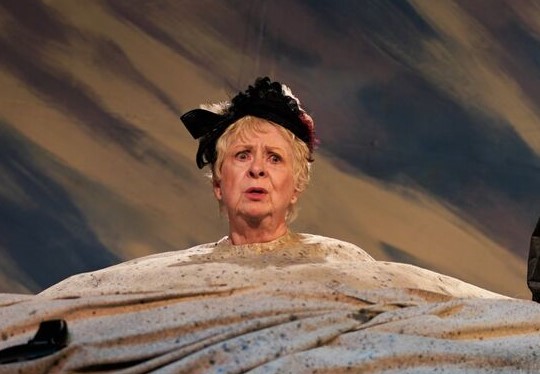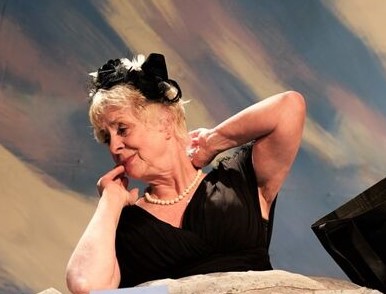
At the start of every day, the bell rings in the morning, and Winnie and Willie are left to their own devices until the bell rings for them to go to sleep. The only hang-up? Winnie is buried up to her waist in a hill of dirt in the middle of nowhere, under a blazing sun so hot that it sets her umbrella on fire. Willie, at least, can move around, but he still doesn’t have a lot of mobility. He also won’t talk to Winnie outside of reading her the names of articles in his newspaper.
So goes the play Happy Days, written by Irish playwright Samuel Beckett, best known for a style called ‘Theatre of the Absurd’. Like in his other masterpiece, Waiting for Godot, Beckett takes a premise that sounds like it wouldn’t work on stage, then deconstructs it to its base components. And, just like in Waiting for Godot, Happy Days works.
In Happy Days, the focus is on Winnie, trying to fill the day as she becomes increasingly buried in dirt. Winnie reflects about her and Willie’s life together, and perhaps on the meaning of life as a whole. The exact nature of the metaphor (if there even is one) is vague and left to the audience to interpret. Indeed, the audience is never explicitly told why the two are on the hill — at one point, Winnie recalls a couple who passed the hill and asked her why she was even up there in the first place. Winnie scoffs, having accepted her situation as fact, and never explains why she’s buried there in the first place.
In Victoria’s Blue Bridge production of Happy Days, Donna Belleville naturally carries the show, believably selling her struggle to keep herself preoccupied throughout the day. Belleville especially shines in the second act, in spite of the fact she is almost entirely buried at this point. Even Willie, portrayed by Michael Armstrong, with the few lines that he has, leaves a strong impression on the audience when he finally moves around on stage in the second act, and his the sudden movement in a stationary world feels shocking.

While the concept and the ideas explored in Happy Days are unique, the stillness of the play might be a big roadblock for some. There is little movement in the actors beyond Winnie’s limited interactions with the few props she has access to, and Willie sliding behind the set with his back to the audience.
It isn’t engaging on a visual level — the audience is staring at a woman in a dirt mound for over an hour. After a while, it can blend together and get boring for some people. But it isn’t supposed to be visually engaging. When things start moving, it immediately catches the eye of the audience. This technique is mainly employed at the end of the show, making the final moments really stand out.
Happy Days is very much a ‘love it’ or ‘hate it’ kind of production. If Happy Days doesn’t interest you from its premise alone, it may not be the production for you — in spite of the strong performances. And for people interested in absurd existentialism, or fans of meta-textual theatre with quiet, haunting and ambiguous endings, Happy Days is worth the shot.
This article has been updated to reflect that Samuel Beckett was Irish, not French. We regret this error.








